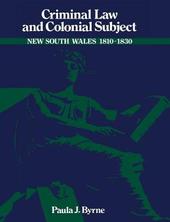
|
Criminal Law and Colonial Subject
Hardback
Main Details
Description
1810-1830 was a crucial period in the development of New South Wales as the legal foundations of a free-settler and emancipist society were built into the predominantly convict colony during this period. This book explores the relationship of a colonial people with English law and looks at the way in which the practice of law developed among the ordinary population. Paula Jane Byrne traces the boundaries between property, sexuality and violence, drawing from court records, dispositions and proceedings. She asks: what did ordinary people understand by guilt, suspicion, evidence and the term 'offence'? The book reconstructs the legal process with great detail and richness and is able to evoke the everyday lives of people in the colony. It focuses on the different valuing of males and females and analyses the complex gender relations of the early colony. This book innovatively ties recent ideas on convict society and Australian colonial women's history to the legal, economic and social history of early NSW. It will be an important book for readers in Australian history, women's history and legal history.
Reviews'Philip Davis and Joe Byrne inject life into the statistical bare bones of sectoral balance sheets. These stock data give a current picture of the accumulated flows (deficits/surpluses) of bygone years, and of their financing patterns. In turn, knowledge of this changing history, and of the current stock position, gives the authors an excellent platform for discerning likely future financial trends, including a discussion whether bank-based (Continental Europe and Japan) and market-based systems (Anglo-Saxon countries) are likely to converge. Questions about the nature, and relevance, of differences in financial structures are perennial. Those concerned with such issues will find this book a 'must buy'.' Professor Charles Goodhart, LSE and Bank of England
|